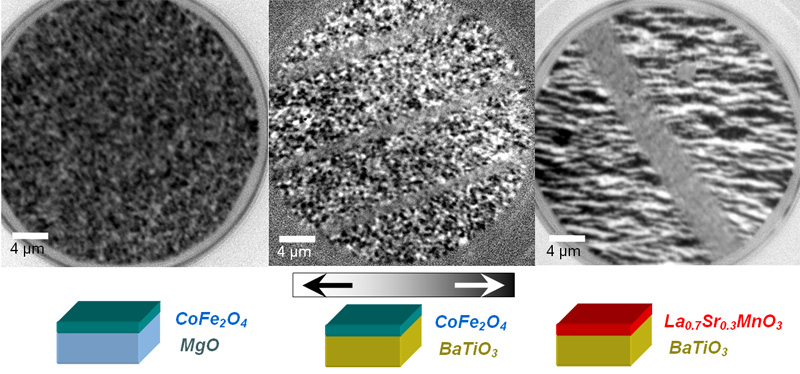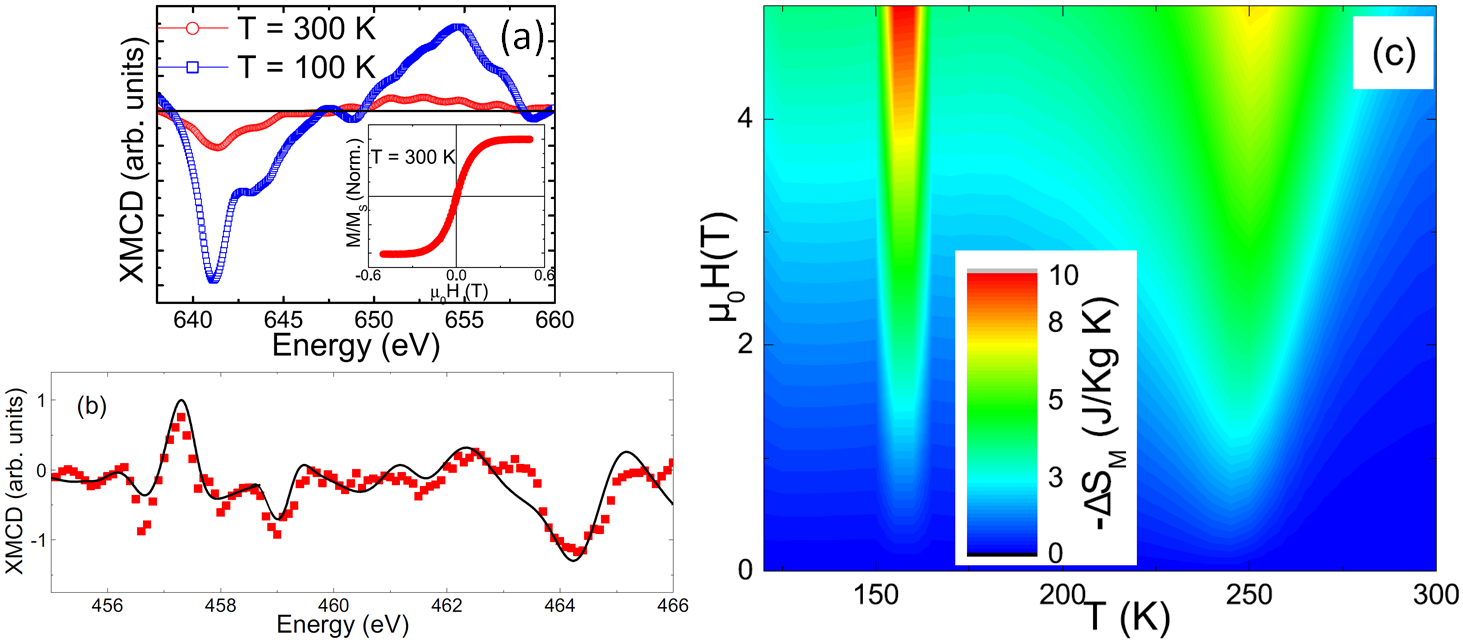Complex Oxide Composites
Complex oxides can have any number of physical properties, including magnetism, ferroelectricity, superconductivity and multiferroicity. Therefore composites containing different complex oxide materials can provide a wealth of interesting physics and novel functionality for applications. We have shown, using X-ray photoemission electron microscopy (X-PEEM) and laboratory-based methods that, by combining materials such as ferromagnetic (La,Ca)MnO3 (LCMO), ferrimagnetic CoFe2O4 (CFO), dielectric SiO2, and ferroelectric BaTiO3 (BTO) in the form of thin films, we can achieve novel physical properties.
For multiferroic composites, the goal is to electrically switch the magnetic states [1]. Towards this aim, we have gained insight into the magneto-electric interaction between a ferroelectric BTO substrate and an epitaxial CFO ferromagnetic thin film using a combination of x-ray circular and linear dichroism spectromicroscopy [2]. We found an induced linear dichroism in the ferromagnetic films whose origin is structural in nature, and directly corresponds to the ferroelectric domain structure of the BTO substrate. A corresponding modulation in circular dichroism contrast (Fig. 1) illustrates the strong magnetoelastic coupling in these artificial multiferroic systems.

It is also possible to improve the multiferroic properties of BTO/CFO composite materials by combining superparamagnetic CFO and ferroelectric BTO nanoparticles, which are mixed together and spin-coated into thin-film form, and enhance the interface-to-volume ratio [3]. We found that there is an optimum weight ratio with a limit of 5 wt% CFO, due to increased leakage and reduced ferroelectric poling efficiency. The dilute composite exhibits fully switchable ferroelectric characteristics and superparamagnetism at room temperature. XMCD measurements demonstrate coupling between the electrical and magnetic degrees of freedom that manifests itself as a reorientation of easy magnetization axis from out-of-plane to in-plane upon in-plane electric poling. Hence, these nanocomposite thin films have the potential for room temperature electric control of magnetism, magnetic field sensors and actuators, energy harvesting, memory elements, and microwave devices.
We also investigated thin-films comprised of preformed superparamagnetic CFO and dielectric SiO2 nanoparticles [4] with synchrotron x-ray circular dichroism and magneto-optical Kerr effect measurements. We demonstrated that, by mixing 50 wt% or less SiO2 nanoparticles into a CFO matrix, we could tune the spontaneous magneto-optical Kerr rotation as well as the perpendicular magnetic anisotropy that is a result of stresses induced during the material synthesis. It is therefore possible to tune the magneto-optical properties of these materials for use in magnetic recording applications as well as magneto-optical waveguides.

Finally, we have demonstrated using X-PEEM and magnetometry measurements that there is a modification of the electronic configurations at the interface of a LCMO/BTO epitaxial film [5]. As a result of the interfacial coupling between the two materials, there are small scale ferromagnetic correlations nearly 50 K above the Curie temperature of LCMO, as well as induced ferromagnetic ordering in BTO giving rise to room temperature ferromagnetism (Fig. 2a and b). The addition of the BTO capping layer also leads to large magnetocaloric effect at 150 K and an enhanced magnetocaloric effect at 250 K due to the orthorhombic-rhombohedral and orthorhombic-tetragonal structural phase transitions in BTO, respectively (Fig. 2c). We have therefore demonstrated a novel method of strain engineering that enhances the magnetic properties. This flexible approach may be applied to enhance and control further phenomena in complex oxide heterostructures such as superconductivity and multiferroicity.
References:
- Single domain spin manipulation by electric fields in strain coupled artificial multiferroic nanostructures
M. Buzzi, R.V. Chopdekar, J.L. Hockel, A. Bur, T. Wu, N. Pilet, P. Warnicke, G.P. Carman, L.J. Heyderman, and F. Nolting, external pagePhys. Rev. Lett. 111, 027204 (2013)call_made - Spatially resolved strain-imprinted magnetic states in an artificial multiferroic
R.V. Chopdekar, V.K. Malik, A. Fraile Rodríguez, L. Le Guyader, Y. Takamura, A. Scholl, D. Stender, C.W. Schneider, C. Bernhard, F. Nolting, and L.J. Heyderman, external pagePhys. Rev. B 86, 014408 (2012)call_made - Nanoparticle-Based Magnetoelectric BaTiO3-CoFe2O4 Thin Film Heterostructures for Voltage Control of Magnetism
D. Erdem, N.S. Bingham, F.J. Heiligtag, N. Pilet, P. Warnicke, C.A.F. Vaz, Y. Shi, M. Buzzi, J.L.M. Rupp, L.J. Heyderman and M. Niederberger, external pageACS Nano 10, 9840 (2016)call_made - CoFe2O4 and CoFe2O4 -SiO2 Nanoparticle Thin Films with Perpendicular Magnetic Anisotropy for Magnetic and Magneto-Optical Applications
D. Erdem, N.S. Bingham, F.J. Heiligtag, N. Pilet , P. Warnicke, L.J. Heyderman and M. Niederberger, external pageAdv. Funct. Mater. 26, 1954 (2016)call_made - Interfacial room temperature magnetism and enhanced magnetocaloric effect in strained La0.66Ca0.34MnO3/BaTiO3 heterostructures
N.S. Bingham, A.K. Suszka, C.A.F. Vaz, H. Kim, and L. J. Heyderman, external pagePhys. Rev. B 96 (2), 024419 (2017)call_made
